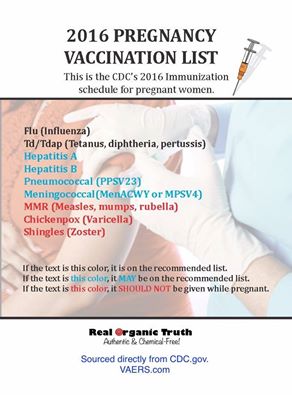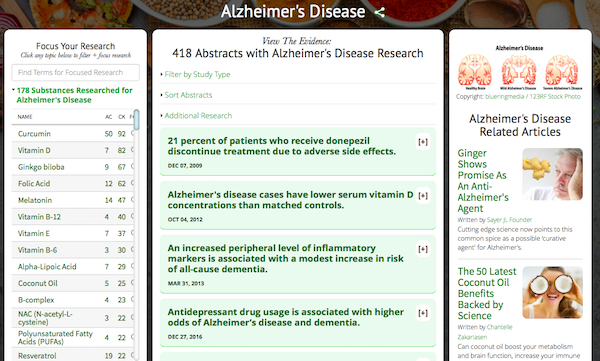.jpg)
Scientists Prove Link Between Aluminum and Early Onset Alzheimer’s Disease
Monday, January 2nd 2017 at 6:00 pm
.jpg)
In today's world, aluminum is omnipresent, building up within our system from everyday products. Now, we are learning that aluminum toxicity can manifest itself in alarming ways.
As many of us are aware, the human body is being bombarded with aluminum in everyday products. Many of our foods, vaccinations, medications, baby products, cosmetics, cleaning products and even soft furnishings contain aluminum and it appears that we are powerless to prevent the ever-increasing onslaught.
This is extremely worrying because, according to Professor Exley, a scientist from Keele University in Staffordshire, aluminum can accumulate in the body and has the potential to do harm wherever it ends up.
A Little Background Information
In a 2014 press release, Exley stated:
“The biological availability of aluminium or the ease with which aluminium reacts with human biochemistry means that aluminium in the body is unlikely to be benign, though it may appear as such due to the inherent robustness of human physiology. The question is raised as to ‘how do you know if you are suffering from chronic aluminium toxicity?’ How do we know that Alzheimer’s disease is not the manifestation of chronic aluminium toxicity in humans?
At some point in time the accumulation of aluminium in the brain will achieve a toxic threshold and a specific neurone or area of the brain will stop coping with the presence of aluminium and will start reacting to its presence. If the same neurone or brain tissue is also suffering other insults, or another on-going degenerative condition, then the additional response to aluminium will exacerbate these effects. In this way aluminium may cause a particular condition to be more aggressive and perhaps to have an earlier onset - such occurrences have already been shown in Alzheimer’s disease related to environmental and occupational exposure to aluminium.”
In 2014, the link between Alzheimer’s disease and aluminum was largely unproven, but since then a lot has changed.
Link Between Early Onset Alzheimer’s Disease and Aluminum Now Proven
For many years, scientists have claimed that a link between aluminum and Alzheimer's disease has existed. However, up until now, there has been little evidence to support their claims, which has left the scientific community confused.
However, according to scientists from Keele University in Staffordshire, recent studies have now confirmed that aluminum does play a role, in some, if not all, cases of Alzheimer’s disease.
In an article titled, Strong evidence linking Aluminum to Alzheimer’s, recently published on The Hippocratic Post website, Exley explained that:
“We already know that the aluminium content of brain tissue in late-onset or sporadic Alzheimer’s disease is significantly higher than is found in age-matched controls. So, individuals who develop Alzheimer’s disease in their late sixties and older also accumulate more aluminium in their brain tissue than individuals of the same age without the disease.
Even higher levels of aluminium have been found in the brains of individuals, diagnosed with an early-onset form of sporadic (usually late onset) Alzheimer’s disease, who have experienced an unusually high exposure to aluminium through the environment (e.g. Camelford) or through their workplace. This means that Alzheimer’s disease has a much earlier age of onset, for example, fifties or early sixties, in individuals who have been exposed to unusually high levels of aluminium in their everyday lives.”
His most recent study, published by the Journal of Trace Elements in Medicine and Biology in December 2016, titled: Aluminium in brain tissue in familial Alzheimer’s disease, is one of the many studies that he and his team have conducted on the subject of aluminum over the years. However, this study in particular is believed to be of significant value, because it is the first time that scientists have measured the level of aluminum in the brain tissue of individuals diagnosed with familial Alzheimer’s disease.
(Alzheimer’s disease or AD is considered to be familial if two or more people in a family suffer from the disease.)
According to their paper, the concentrations of aluminum found in brain tissue donated by individuals who died with a diagnosis of familial AD, was the highest level ever measured in human brain tissue.
Professor Exley wrote:
“We now show that some of the highest levels of aluminium ever measured in human brain tissue are found in individuals who have died with a diagnosis of familial Alzheimer’s disease.
The levels of aluminium in brain tissue from individuals with familial Alzheimer’s disease are similar to those recorded in individuals who died of an aluminium-induced encephalopathy while undergoing renal dialysis.”
He explained that:
“Familial Alzheimer’s disease is an early-onset form of the disease with first symptoms occurring as early as 30 or 40 years of age. It is extremely rare, perhaps 2-3% of all cases of Alzheimer’s disease. Its bases are genetic mutations associated with a protein called amyloid-beta, a protein which has been heavily linked with the cause of all forms of Alzheimer’s disease.
Individuals with familial Alzheimer’s disease produce more amyloid beta and the onset of the symptoms of Alzheimer’s disease are much earlier in life.”
What Do Their Findings Mean?
To explain the team’s findings in more depth, Exley wrote:
“This new research may suggest that these genetic predispositions to early onset Alzheimer’s disease are linked in some way to the accumulation of aluminium (through ‘normal’ everyday human exposure) in brain tissue.
Ageing is the main risk factor for Alzheimer’s disease and aluminium accumulates in human brain tissue with ageing. Environmental or occupational exposure to aluminium results in higher levels of aluminium in human brain tissue and an early onset form of sporadic Alzheimer’s disease. The genetic predispositions which are used to define familial or early-onset Alzheimer’s disease also predispose individuals to higher levels of brain aluminium at a much younger age.
Aluminium is accepted as a known neurotoxin, for example being the cause of dialysis encephalopathy, and its accumulation in human brain tissue at any age can only contribute to any ongoing disease state or toxicity.”
This is extremely worrying for any pregnant women who have a family history of Alzheimer’s disease, especially if they are considering being vaccinated during pregnancy. Out of the nine vaccinations covering 13 diseases that are currently being offered to pregnant women, five contain aluminum, which could potentially put the baby at greater risk.

See Nurse Vaccinated During Pregnancy with Flu Shot Accused of Shaken Baby Syndrome for details.
Babies Under the Age of 2 Are Being Vaccinated with 4,925 mcg of Aluminum
If babies are being exposed to an unusually high level of aluminum from the moment that they are conceived, then surely, they could face greater risk of neurological disease later in life. The mere fact that scientists have discovered exceptionally high levels of aluminum in the brain tissue of individuals who have died with a diagnosis of familial Alzheimer’s disease, should, if nothing else, alert parents to the dangers of aluminum.
However, it appears this is not the case, as according to one researcher, despite the fact that aluminum is a known neurotoxin, infants and young children are being repeatedly vaccinated with vaccinations containing aluminum during critical periods of brain development.
In his recent paper titled, Aluminum in Childhood Vaccines Is Unsafe, Neil Z. Miller explained that not only are babies being bombarded with vaccinations containing aluminum in the womb, but recent changes to the vaccine schedule have resulted in babies receiving a substantial rise in the number of vaccinations containing aluminum at an earlier age.
He wrote:
“Prior to the mercury phase-out (pre-2000), babies received 3,925 micrograms (mcg) of aluminum in their first year-and-a-half of life. After pneumococcal and hepatitis A vaccines were added to the immunization schedule, babies began receiving 4,925 mcg of aluminum during the same age period—a 25% increase (Figure 1). In 2011, CDC recommended that pregnant women receive a pertussis vaccine (Tdap), which also contains aluminum. Studies show that aluminum crosses the placenta and accumulates in fetal tissue. Thus, millions of babies in utero, infants, and young children were injected with, and continue to receive, unnaturally high doses of neurotoxic substances—mercury and aluminum—long after unsuspecting parents were led to believe that vaccines were purified and made safe.”
In other words, today’s children now receive an extra 1000 micrograms of aluminum in their childhood vaccinations in the first 18 months of life. This increase, plus the aluminum they have already received in utero, has the potential to lead to a lifetime of health problems.
Miller explained that there are more and more vaccinations containing aluminum being added to the vaccine schedule, which can lead to multiple health problems. To demonstrate just how dangerous aluminum can be once it is injected into the body, Miller detailed study after study outlining the serious effects that this neurotoxin can have on the body.
He wrote:
“Numerous studies provide compelling evidence that injected aluminum can be detrimental to health. Aluminum is capable of remaining in cells long after vaccination and may cause neurologic and autoimmune disorders. During early development, the child’s brain is more susceptible to toxins and the kidneys are less able to eliminate them. Thus, children have a greater risk than adults of adverse reactions to aluminum in vaccines.”
This is extremely worrying, especially if you have a family history of Alzheimer’s disease, as according to Mr. Miller, rats that were given extremely small amounts of aluminum, “showed behavioral, biochemical, and histological changes similar to those associated with Alzheimer’s disease.”
He concluded:
“Toxic metals such as aluminum do not belong in prophylactic medications administered to children, teenagers, or adults. Vaccines are normally recommended for healthy people, so safety (and efficacy) standards must be impeccable. Parents, especially, should not be compelled to permit their loved ones to receive multiple injections of toxic metals that could increase their risk of neurodevelopmental and autoimmune ailments. Safe alternatives to current disease prevention technologies are urgently needed.”
Safe alternatives may be needed, but with more and more vaccinations being made mandatory, parents feel as if they have little choice but to play Russian roulette with their children’s lives.
How to Reduce the Body’s Burden of Aluminum
As a solution, Professor Exley has suggested that we aim to reduce the accumulation of aluminum in our brains through everyday activities. One of the ways that Professor Exley has suggested to help reduce the accumulation of aluminum in the body is by drinking a silicon-rich mineral water. According to Exley, silicon protects the body against the toxicity of aluminum, and by drinking a silicon-rich mineral water, his studies have revealed that the aluminum is removed from the human body through the excretion of urine.
See: Silicon-Rich Mineral Water as a Non-Invasive Test of the Aluminum Hypothesis in ‘Alzheimer’s Disease
Readers will find more information on the dangers of aluminum and the research carried out by Professor Christopher Exley listed on the Children’s Medical Safety Research Institute (CMSRI) website.
 For
For
For evidence-based research on Alzheimer's Disease, visit the GreenMedInfo.com Research Dashboard.

Christina was born and educated in London, U.K. She received an A Level in
Psychology and a BTEC in Learning Disabilities. She has spent many years
researching vaccines and adverse reactions. She has an HND injournalism and
media and is currently writing for the American Chronicle, the Weekly Blitz and
Vaccination Truth on immunization safety and efficacy.
Disclaimer: This article is not intended to provide medical advice, diagnosis or treatment. Views expressed here do not necessarily reflect those of GreenMedInfo or its staff.
Internal Site Commenting is limited to members.
Disqus commenting is available to everyone.